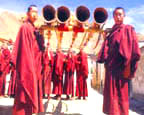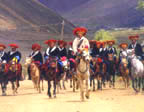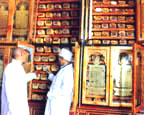|
Potala Palace and Monasteries
Gendun Chophel, et al, A Guide to Buddhist Holy Places , Sichuan Ethnic Publishing House, Chengdu, February 1998. 607 pp. 20 c m. ISBN 7-5409-1430-0. 16 articles on well-known Buddhist holy places in China's Tibetan d hinterland, and also in India, by Padmasambhava, Jigme Lingpa, Chankya Rolpai Dorje, Kathog Situ Chorje, Gendun Chophel and other noted scholars and Buddhist masters in Tibetan history.
Su Bai, An Archeological Survey of Tibetan Buddhist Monasteries, Cultural Relics Publishing House, Beijing, October 1996. 398 pp. Photos and charts. 26 cm. ISBN 7-5010-0886-8. 18 articles in three parts in accordance with districts. Part One: 9 articles on the survey of Buddhist monasteries in Tibet, including Lhasa, Shannan, and Xigaze; Part Two: 6 articles on the survey of Buddhist monasteries in Gansu, Qinghai and Inner Mongolia, particularly the Tibetan Buddhist monasteries built before the end of the Ming Dynasty; and Part Three: 3 articles on the historical materials of two Buddhist pagodas built in the capital city of Dadu ( now Beijing) of the Yuan Dynasty, and some relic sites at Linan (now Hangzhou), the capital city of the Southern Song Dynasty. Appendix: Selected Photos of Buddhist Monastic Architecture in Tibet in the 1950s.
Mei Duo, ed, Buddhist Monasteries of Tibet, China Intercontinental Press, Beijing, December 1996. 17 pp. 19.5?19.5 cm. ISB N 7-80113-172-X. Tibet Pictorial Series. A selection of over 20 color photos about the architecture, Buddhist images and frescoes of the Jokhang Temple, the Potala, the Sakya Monastery, the Tashilhunpo, the Samye and other monasteries in Tibet.
Yang Huilin, Buddhist Realm: Mysterious Tibetan Monasteries, Qinghai People's Publishing House, Xining, August 1997. 31 2 pp . Illus. 20 cm. ISBN 7-225-01362-9. An introduction to the 50 best-known among the numerous monasteries of Tibet, including the Jokhang Temple that has a history of more than 1,300 years, the world-famous Potala, the Samye Monastery where the first seven Tibetans were ordained as monks, and the four great monasteries of the Gelug Sect (Gande n, Drepung, Sera, and Tashilhunpo). In popular and concise language, the author makes an outline of the formation and development of these monasteries, the origin, propagation, doctrines and rituals of various Tibetan Buddhist sects and the differences among them. He also introduces the magnificent architecture, the unique Buddhist statues, the sculptures and frescoes of the monasteries.
Cho-nga, History of Monasteries in Ngari, Tibetan People's Publishing House, Lhasa, October 1999, 182 pp. 20 cm. ISBN 7-223- 01238-2. Ngari Plateau, known as the "Roof of the World" with its long history, distinctive culture and the local-style monasteries stands magnificently o n the west Qinghai-Tibet Plateau. Based on detailed and accurate historical fact s and thorough on-the-spot investigation, the author makes an account of the history and present state of seven known monasteries in Ngari.
Wang Lu, Coming Out of the Snowland: Holy Relics of Tibetan Buddhism, Qinghai People's Publishing House, Xining, Septemb er 1 998. 234 pp. Illus. 18 cm. ISBN 7-225-01600-8. An introduction to Tibetan cultural relics and historical sites in the hinterland of China: Tibetan Buddhist monasteries, pagodas, stupas, caves, r are cultural relics, eminent monks and relevant important historical events in Beijing, the Imperial Summer Resort at Chengde, Mt. Wutai, Mongolian-inhabited areas, Northeast area, Qinghai, Xinjiang, Hexi Corridor of Gansu, Ningxia, Shaanxi , Central Plain, Yunnan, Sichuan, Jiangsu, Zhejiang, Shanghai, Guangdong, Hong Kong, Macao, and Taiwan. With a preface by Lhapa Phuntsok.
Thomporwa Thubten Gyeltsen, ed, Sacred Palace in the Sno wland: the Potala, China Travel and Tourism Press, Beijing, June 1996 . 194 pp. 29 cm. ISBN 7-5032-1237-3. Hardcover. Edited and translated fr om Tibet an into Chinese by Thomporwa Thubten Gyeltsen, et al; photos by Bian Zhiwu and Ding Changzheng; English translation by Cao Yong and He Liu. The Potala was placed on the "World Cultural Heritage List" by UN ESCO in 1994, the Wood-Dog year of Tibetan calendar, and put under protection as a place of historical interest and scenic beauty. At the same time, the Cultural Relics Research Section with the Potala Administration Office specially select ed some Tibetan cultural relics for this album, with over 200 pictures and 20,00 0 characters. All the annotations are in both Chinese and Tibetan.
Mei Duo, ed, The Potala Palace, China Intercontinental Press, Beijing, December 1996. 21 pp. Illus. 20X20 cm. IS BN 7-80113-170-3. Tibet Pictorial Series. Color photos, showing the magnificent architecture of the Potala after the renovation, which began in October 1989 and ended in September 1994. The Potala was placed on the "World Cultural Heritage list" in December 1994.
The Office of the Renovation Project of the Potala and the China Cultural Relics Research Institute, The Potala Pa lace in Tibet (two volumes), Cultural Relics Publishing House, Beijin g, October 1996. 553 pp. Illus. 35?26 cm. ISBN 7-5010-0894-9. Hardcover. An introduction to the renovation project of the Potala from 1989 t o 1994, based on Report on the Renovation Project of the Potala Palac e in Tibet published by the Cultural Relics Publishing House in 1994. Two parts. Part 1: research papers on the general conditions, architecture, frescoes, sculptures, pagodas, stupas, thangkas, stone tablets and cliff carvings o f the Potala; Part 2: "Design Manual for the Restoration Project of the Potala, " "Technological Summary of the Renovation Project," and "A Chronicle of Events of the Renovation Work." Appendices: 101 surveying and mapping charts and 380 color plates with captions and notes.
Tibet Autonomous Region Survey and Design Institute, and History Section with China Building Technology Research Institute, The Potala Palace, China Architecture and Building Press, Beijing, March 1999. 46 2 pp. Illus. 28 cm. ISBN 7-112-03274-1. Hardcover. The editors made an overall surveying and mapping of the Potala and took photos of it and collected relevant materials in 1980. They went to over 20 dzongs (counties) of Tibet to make investigation on ancient buildings in 1981. This book is a result of the work mentioned above. Ten chapters: history of the Potala, its general plan, the Potala and its blockhouses, the White Palace, Red Palace, murals and images, pagodas and stupas, Namgyal Dratsang, structure and construction, and artistic treatment of the construction. With 11 appendices, including "Names of Main Halls in the Potala."
Meng Zi, et al, ed, Tashilhunpo: The Resident Monastery of the Panchen Lama, Ethnic Publishing House and Foreign Languages Press, Beijing, September 1993. 175 pp. Illus. 26 cm. ISBN 7-105-02035-0. Chines e-Tibetan bilingual edition. A pictorial album with more than 200 photos of Tashilhunpo Monaster y in seven parts: Tibetan Buddhism and its monasteries, the greatest monastery o f the Gelug Sect of Tibetan Buddhism in the Ulterior Tibet (Tsang), the history of the monastery, major buildings, the organization of the monastery and life of the monks, the Panchen Lamas pedigree, and festivals in the monastery.
Zheng Dui, ed, Tashilhunpo Monastery, China I ntercontinental Press, Beijing, November 1997. 21 pp. 20 cm. ISBN 7-8011 3-327-7. Six Main Monasteries of the Yellow Sect Pictorial Series. More than 30 color photos of Tashilhunpo Monastery's architecture, Buddhist images and statues, monks life, religious activities, tsadr up (embroidered fabrics), and butter sculptures.
Phuntsok Namgyel, ed, Tashilhunpo Monastery , Encyclopedia of China Publishing House, Beijing, November 1998. 190 pp. 28 cm. I SBN 7-5000-6101-3. Hardcover. Color photos of the buildings, stupas, sculptures, murals, thangkas and the gifts bestowed by emperors of the Qing Dynasty to the Panchens of the Tashilhunpo Monastery, which is situated at the south foothills of the Nyima Moun tains of Xigaze in Tibet and listed as an important cultural relic site under St ate-level protection in 1961.
Xiong Wenbin, ed, Ganden Monastery, China Intercontinental Press, Beijing, November 1997. 17 pp. 20 cm. ISBN 7-80113- 311-0. Six Main Monasteries of the Yellow Sect Pictorial Series. An album of more than 20 color photos, introducing the buildings, monks life, Buddhist images and statues, sutras, butter sculptures, embroidered thangkas, religious instruments and murals of Ganden Monastery, which is located in Dagze County of Lhasa in Tibet.
Xiong Wenbin, ed, Sera Monastery, China Inter continental Press, Beijing, November 1997. 17 pp. 20 cm. ISBN 7-80113-31 9-6. Six Main Monasteries of the Yellow Sect Pictorial Series. An album of more than 20 color photos of the magnificent buildings, monks life, Buddhist images and statues, murals, and pilgrims of Sera Monastery , which is located to the north of Lhasa along the south foothills of the Sera Ozer mountains in Tibet.
Zheng Dui, ed, Drepung Monastery, China Inter continental Press, Beijing, November 1997. 21 pp. 20 cm. ISBN 7-80113-32 3-4. Six Main Monasteries of the Yellow Sect Pictorial Series. An album of more than 20 color photos of the buildings, murals, Buddhist statues, religious activities, thangkas, and monks life of Drepung Monastery, which lies about 10 km. west of Lhasa along the south foothills of the Gephel Ozer mountains in Tibet.
Mei Chai, ed, Sakya Monastery, China Inte rcon tinental Press, Beijing, November 1998. 79 pp. Illus. 26 cm. ISBN 7-8011 3-393-5. Chinese-English bilingual edition. An album of color pictures, giving a detailed account of the history, architecture, Buddhist images, cultural relics and rituals of Sakya Monastery, the main monastery of Sakya sect, which is located in the Sakya County of the Tibet Autonomous Region.
Dralha Dawa Sampo, Garton Monastery in Tsang, Tibetan People's Publishing House, Lhasa, June 2000. 147 pp. Illus. 20 cm. ISB N 7-223-01178-5. An account of the establishment of Garton Monastery, its holy relic s and Buddhist statues, and its renovation.
Peng Qisheng, ed, The Monasteries, Temples, Pagodas and Caves in Qinghai, Qinghai People's Publishing House, Xining, September 1998. 442 pp. Illus. 20 cm. ISBN 7-225-01569-9. Six parts: monasteries, temples, pagodas, caves, Taoist temples, an d Islamic mosques, with the focus on some 200 monasteries, temples, Buddhist pagodas, and caves built in Qinghai before 1840, and some well-known ones built after 1840. Also introduces the monastic architecture of Tibetan Buddhism, Chinese Buddhism, Islam, and Taoism, and their history, religious sects, religious personages, architectural art, sculptures and paintings. With a great number of illustrations, and a list of monasteries, temples, pagodas, and caves in Qinghai.
Qinghai Hainan Tibetan Autonomous Prefecture Buddhist Association and Tibetan Buddhism Research Section with the China Tibetan Language Senior Buddhist College, A Brief History of the Monasteries in Hainan Prefecture,Qinghai Ethnic Publishing House, Xining, September 1999. 767 pp. Illus. 20 cm. ISBN 7-5420-0849-8. An introduction to the history and present situation of 122 monaste ries in the Hainan Tibetan Autonomous Prefecture of Qinghai. With a preface by R nchen Gyal.
Yang Guiming, The Culture of Kumbum Monastery , Qinghai People's Publishing House, Xining, December 1997. 283 pp. Ill us. 20 c m. ISBN 7-225-01447-1. A comprehensive introduction to Tsongkhapa's birthplace, Kumbum Mo nastery in Huangzhong County of Qinghai Province and its cultural phenomenon, the birth of Tsongkhapa, the reincarnation of successive trulkus, rituals for the inauguration of abbots and monk officials, monastic education, the four great Buddhist meetings, Buddhist festivals and customs, the three consummate arts (butter sculptures, murals and embroidered fabrics), statues, pagodas, and architectu ral arts, interwoven with fairy tales, legends and stories. With a preface by Agyal Losang Thubten. Two appendices: "Inspectio n Tours of Kumbum Monastery by Famous Personages of Past Ages" and "Permits for Buddhist Monks to Ask for Alms."
Chen Lijian, ed, Kumbum Monastery, China Intercontinental Press, Beijing, November 1997. 17 pp. 20 cm. ISBN 7-80113-3 15-3. Six Main Monasteries of the Yellow Sect Pictorial Series. A picture album of more than 20 color photos, introducing Kumbum Mo nastery's architecture, Buddhist statues, tsadrup (embroi dered fabrics), thangkas, and butter sculptures.
Jiang Huaiying and Liu Zhanjun, Office in Charge of the Maintenance Project of Qinghai's Kumbum Monastery and Institute of Chinese Relics, ed, Report on the Repair of Kumbum Monastery in Qinghai, Cultural Relics Publishing House, Beijing, July 1996. 337 pp. Illus. 26 cm. ISBN -7-5010-0902-3. Hardcover. An introduction to the repair of Kumbum Monastery, the whole process from the approval of the project by the State Council in 1991 to the completion of the re pair in 1996. Two parts: research and repair. The research part includes introductory remarks, main buildings of the monastery and their dates of construction, esign and structure; and the repair part contains a summary of the repair work, a chronicle of events of the project and the main organization and name list of personnel for the project. With a profusion of pictures, including 86 measured drawings, 78 black-and-white pictures and 62 color pictures, as well as "Request of the Qinghai Provincial People's Government for Instructions on Rush Re pair of the Ancient Buildings of Kumbum Monastery" and other six documents. With also four prefaces by La Bingli, Pema and others.
Xie Zuo, Qutan Temple (third edition), Qinghai People's Publishing House, Xining, August 1998. 109 pp. Illus. 18 c m. ISBN 7-225-01561-3. This edition is based on the first and second editions published by the same publishing house, in July 1982 and December 1984. The first edition was listed in the Catalogue of Chinese Publications in Tibetan Studies (1949-1991) published by the Foreign Languages Press in 1994.
Chen Lijian, ed, Labrang Monastery, China Intercontinental Press, Beijing, November 1997. 17 pp. 20 cm. ISBN 7-80 113-331-5. Six Main Monasteries of the Yellow Sect Pictorial Series. A picture album of more than 20 color photos, introducing Labrang Monastery in Gannan Tibetan Autonomous Prefecture of Gansu and its magnificent architecture, festival of displaying Buddha's image, rare sutras, murals, and religious activities.
Damcho, History of Labrang Monastery, Ethnic Publishing House, Beijing, June 1998. 170 pp. 20 cm. ISBN 7-105-03126-3. Inside and Outside of Buddhist Chapel Series. An account of the long history, brilliant culture and distinctive customs of Labrang Monastery, a seat of successive Jamyang Living Buddhas, and a holy seat for the Gelug Sect of Tibetan Buddhism to spread its doctrine.
Drukthar, The Establishment of Labrang Monastery and Its Six Colleges, Gansu Ethnic Publishing House, Lanzhou, November 1998. 454 pp. Illus. 20 cm. ISBN 7-5421-0621-X. Hardcover. Nine chapters. Chapters 1-2: the establishment of Labrang Monastery and the monastic education of Tibetan Buddhism; Chapters 3-8: the College of Ex teric Buddhism, the Lower College of Theology, the College of the Wheel of Time , the College of Medicine, the College of the Happy Thunderbolt, and the Upper College of Theology; Chapter 9: the Nanchen (mansions of Living Buddhas) and eminent monks of the Labrang.
Chari Kalsang Thongmey,History of the New Shichang Mona stery, Gansu Ethnic Publishing House, Lanzhou, July 1995. 561 pp. Il lus. 20 cm. ISBN 7-5421-0332-6. A brief account of the New Shichang Monastery built by the Third De tri Rinpoche Jamyang Thubten Nyima in the south Domed: its construction, the founding of the college for studying sutras, the successive incarnations, stupas, and its present size. With a biography of Thubten Nyima.
Dong Yonten Gyatso, History of Rew a Monastery, Gansu Ethnic Publishing House, Lanzhou, November 1996. 7 4 pp. 19 cm. ISBN 7-5421-0477-2. A brief account of Tsultrim Rinchen, the founder of Rewa Monastery, and his next reincarnation, the establishment of the monastery, and a catalogue of the Buddhist images, sutras and pagodas preserved in the monastery.
Jamyang Jigtse, History of Kathog onastery, Sichuan Ethnic Publishing House, Chengdu, January 1996. 24 0 pp. Illus. 20 cm. ISBN 7-5409-1659-1.A detailed account of Kathog Monastery, a well-known monastery of t he Nyingma Sect, built in the Palyul County of Garze Tibetan Autonomous Prefecture, Sichuan, in the 12th century, the lineage system of its successive grand lam as, and the life stories of teachers of morals (Acarya), tutors, and other eminent monks.
|



